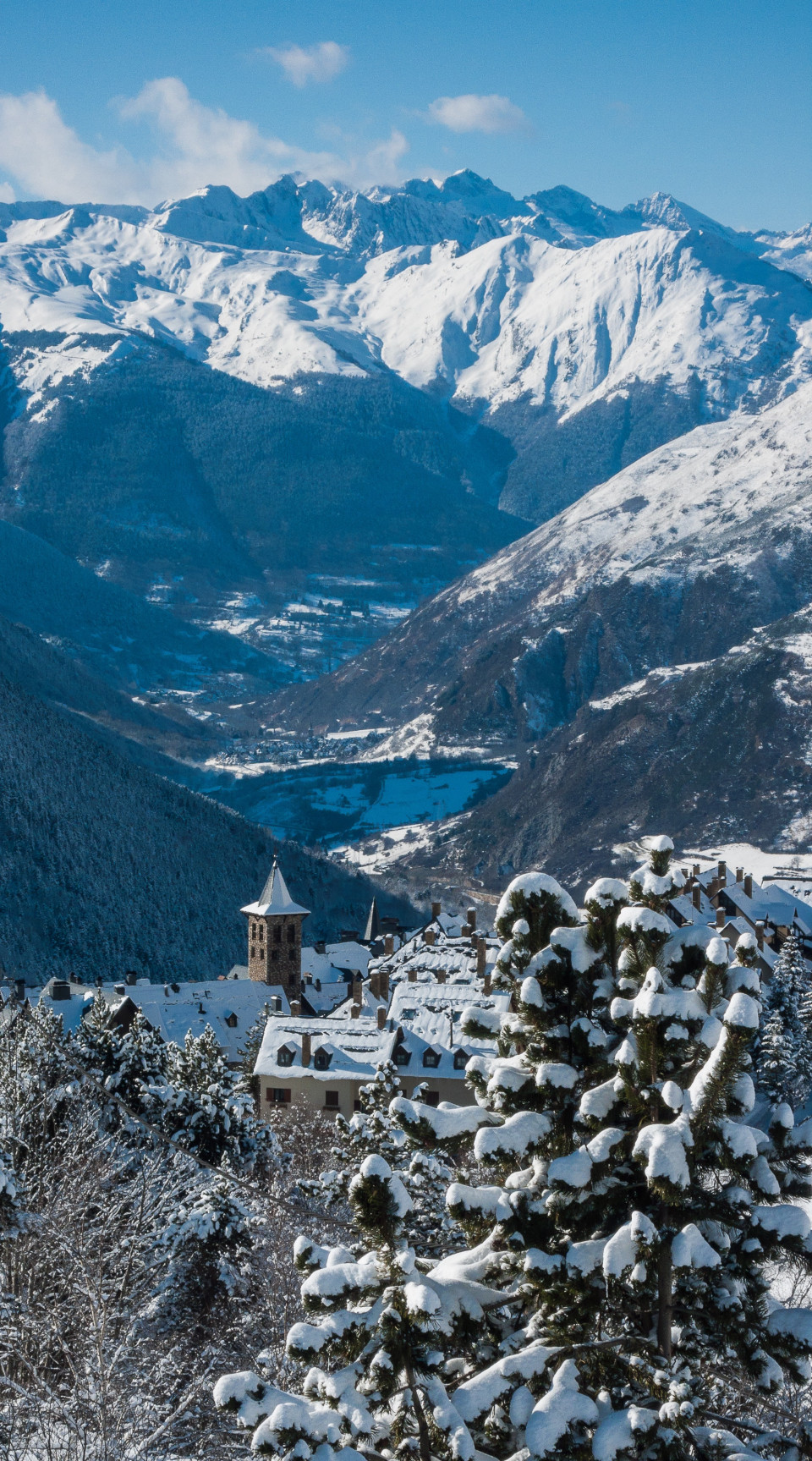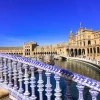The best time to come to Barcelona and Catalonia
Catalonia boasts more than 300 days of sunshine a year, after all. In addition, every month offers the visitor something special: perhaps some special gastronomic treats, such as calçots in the winter months or mussels in summer, or activities like visiting vineyards in autumn, or skiing in winter.
Spring
Spring is, for many, the perfect time to visit Barcelona and Catalonia. Never very cold, temperatures are mild and the city streets are less crowded, while out in the countryside, the fields and hills come alive with blossom and wild flowers. Spring is an ideal time to visit for a number of outdoor activities, and you may even find it’s warm enough to sunbathe and swim in late May and June. Indeed, in late spring there are some who choose to spend the morning on the ski slopes and the afternoon on the beach.
Nature-lovers will delight in the spring flowers along Catalonia’s myriad hiking paths, which include everything from high-mountain treks in the Pyrenees to panoramic cliff walks along the Costa Brava. April and May is a good time for cyclists to visit, whether you’re an experienced biker looking for the challenges of the Pyrenees or prefer the flat, inviting paths of the Vias Verdes, the converted train lines that are now popular paths for walking and biking.
Spring is also calçot season: these big, juicy spring onions are roasted over a barbecue until black, then stripped of their skins, dipped into a nutty romesco sauce, and eaten joyously, usually with a big group of friends and a porró (long-spouted pitcher) of wine. The inviting country town of Valls, in the province of Tarragona, is in the heart of calçot territory, and a fine place to visit for a convivial calçotada. It’s also famous throughout Spain for its top teams of castellers, who build the astonishing human towers Catalonia is famous for, in a remarkable demonstration of cooperation and bravery. There are castellers throughout Barcelona, with events held most weekends in spring and summer.
There are scores of great festivals throughout the year starting in January when you can witness curiosities such as the blessing of the animals at the Tres Tombs festival in Barcelona. February brings the Carnival, held all over Catalonia but especially in Sitges, where the streets are literally carpeted with flowers, the fountains are garlanded and the LGBTQ community send a glittering, extravagant parade around the old town. Girona takes up the Spring floral theme in May, with its wonderful ‘Temps de Flors’ festival, which sees exquisite installations and carpets made of flowers installed throughout its enchanting medieval quarter. Also in late spring, on the feast of Corpus Christi, you can watch the enchanting tradition of the ou com balla, the ‘dancing egg’: fountains are covered with flowers and seasonal fruit, and a hollow egg is set on top of the water jet to ‘dance’. You can see this in several places in Barcelona’s Gothic Quarter, including the cathedral, and in towns and cities across the region.

Summer
In summer, the days are long and languid, the nightlife really does last all night, and you can dine out on charming squares, or by the sea, enjoying the breeze coming off the waves.
If the heat gets too much in the height of summer, you can cool off at the beach somewhere along Catalonia’s 600-kilometre coastline, which has endless golden sandy beaches, turquoise bays, and remote headlands to explore. Every water sport you can think of is possible along this stunning stretch of the Mediterranean coast, including snorkelling and diving in the marine reserves of the Iles Medes or the Cap de Creus, sailing, kite-surfing and paddle boarding. On the more popular beaches, you can join the fun: beach volleyball, beach bars and DJs, are just some of the entertainment.
If you love pristine waters you can take a skippered yacht out in search of secret coves, and perhaps enjoy a wonderful Catalan seafood lunch at beach restaurant accessible only by boat. Or glide along the Ebro River, past the golden fields of rice, to eat freshly harvested mussels at a restaurant floating right on top of the beds.
If your preference is to head inland, you can cool off in natural pools and waterfalls, or head up into the mountains, where rafting, canyoning, and horse-riding are just some of the activities available. You could also try one of Catalonia’s most unique outdoor pursuits: bear-tracking in the Pyrenees. There are believed to be between 30 and 36 brown bears along the Spanish-French border in this eastern swathe of the Pyrenees, and you can visit the Casa del Oso Pardo (House of the Brown Bear), an information centre in the Val d’Aran, before heading out into the mountains armed with telescopes in the hope of spotting one of these fantastic, elusive creatures.
The Festa de Sant Joan, a fire festival in honour of John the Baptist which also celebrates the summer solstice is held in late June and brings whole families out to build huge bonfires and set off fireworks from the beach. In July Barcelona hosts its biggest performing arts festival, the Grec, and there are superb festivals of classical and contemporary music, film and fireworks across the region. Many of Catalonia’s villages have their popular traditional festivals in August, when you can appreciate the marvellous feats of the castellers as they build their human castles, or watch the fire-spitting demons and dragons in the correfoc.
From late August to November there are numerous festivals in honour of the grape harvest, and the towns of the Penedès and other Catalan wine-making regions host all kinds of fantastic activities. Some of the festivals have a font del vi, where a local fountain spouts wine rather water: the main square in Prades, for example, is dominated by a large, circular fountain, which erupts with cava during the town’s July festival to the delight of the crowds massed around it.
The coast and most of the mountain retreats are busy in summer, but it’s worth noting that city hotels, particularly in Barcelona, offer some of their best deals in August, which is when many businesses close for the whole month. Some shops and restaurants also close during August so if you are visiting then.

Autumn
September is a wonderful time to visit: the evenings are still warm enough to sit out with a bottle of wine until the early hours, the sea feels like velvet, and there is the added bonus that the summer crowds have dropped off.
The end of summer is marked with intense, but usually short-lived rain storms, which briefly whip up the waves on the beaches, then leave the air clean and sparkling bright—ideal for bracing walks, punctuated by stops at a clifftop bar or restaurant. Inland, the forests and hills begin to turn gold and scarlet, and the mushroom-pickers start foraging. Bolets (wild mushrooms) are highly sought after delicacies, and they begin to appear on local menus, along with local game and warming stews, particularly in the villages and towns at higher altitudes. There are more festivals celebrating the grape harvest, including one in little Verdú, in Lleida province, which boasts a richly decorated, century-old fountain which gushes with the robust Costers del Segre wine during its October wine festival. In October and November, you can also try the new, freshly pressed olive oil: the olive oil of Tarragona is considered by some of the world’s top restaurants as the finest in the world.
The milder temperatures of autumn make it an ideal season for hiking, biking and most outdoor activities, from canyoning to climbing. It’s also a wonderful time of year to take to the skies, and sail in a hot air balloon over extraordinary landscapes, such as the volcanoes of the Garrotxa. Nature-lovers should note that Catalonia boasts a greater diversity of bird life than almost anywhere else in Spain, thanks to its wide range of habitats. Although considered a superb birding destination year-round, September brings the added excitement of migrating species. The Ebro Delta is considered by many to be on a par with the more famous Doñana National Park in Andalucia for the variety of birdlife it supports, but other good birding areas include the Parc Natural dels Aiguamolls de l’Empordà and the magnificent Aigüestortes National Park.

Winter
In winter, temperatures along the coast rarely drop below 10 degrees C (50 degrees F), and it’s often considerably warmer. The beaches are empty and perfect for strolling, and many beach bars (xiringuitos) don’t close until November, so you can stop for lunch or drinks.
Inland, it’s a very different picture: from early December, the ski resorts are open for business, offering nearly 500 kilometres of runs for skiers and snowboarders. There are endless possibilities for other winter sports, among them snowshoeing, cross-country skiing, dog-sledding, and ice-climbing. If you’re planning a family holiday to Barcelona, you’ll find plenty to do to keep even small children entertained, with snow parks full of snowmen, toboggan rides, and other fun activities. There are numerous ski resorts for you to choose from, including exclusive Baqueira Beret (where Spain’s Spanish royal family skis), which offers some of the most extensive facilities in the Pyrenees.
As Christmas approaches, the towns set up their December markets, and you can enjoy the sight of some unique Catalan traditions. These include the tío, a wooden log with a smiling face and a red beret (barretina), which is traditionally hit with a stick by children on Christmas Eve until it brings forth sweets and toys. Then there are the Christmas manger scenes, pessebres, found in every Catalan home. And if you want to get yourself a Christmas tree, head to the delightful mountain village of Espinelves, where the steep, narrow streets and pretty squares are filled with thousands of fine specimens.
In terms of hotels and restaurants, options in the winter will be limited along the coast, where many places close down over the winter. However, the choice remains excellent in Barcelona and in most towns and villages across the region, and there are lots of great reasons to spend Christmas or New Year here and celebrate the season in style.
Your Catalonia Experts
If you liked this page then please share it using the buttons below. You might also want to take a look at our page on 101 Incredible things to do in and around Barcelona or browse our blog for more holiday ideas.



